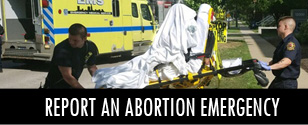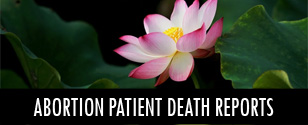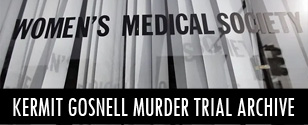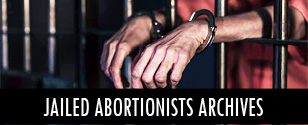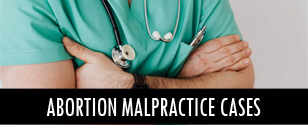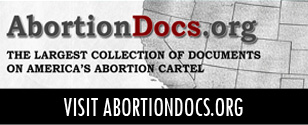This is the second part of an exclusive Operation Rescue report concerning the Sedgwick County Grand Jury that investigated late-term abortionist George Tiller in the death of Christin Gilbert. It is based on information provided by a source inside the Grand Jury process that has asked to remain anonymous.
The first part of the report dealt with the events surrounding the abortion and death of Christin Gilbert. It can be read here: Part One: What Really Happened to Christin Gilbert?
Today’s segment will explore the grand jury process and some of the jury frustrations with their limitations and stonewalling that prevented them from getting to the truth.
Part Three will cover what the source refers to as the “fraternity” of officials that protect Tiller, and the final installment will cover unanswered questions and where we must go from here.
PART TWO: Inside the Grand Jury
Wichita, KS — A Sedgwick County grand jury was convened on May 22, 2006, at the request of a citizen petition initiated by a grassroots coalition that included Operation Rescue. The job of the grand jury was to investigate late-term abortionist George R. Tiller in the death of a 19-year old Down syndrome girl, Christin Gilbert, who died from complications to a third-trimester abortion received at Women’s Health Care Services in Wichita, Kansas, in January of 2005.
The grand jury panel consisted of 15 jurors selected from citizens in Sedgwick County. Judge Richard Ballinger oversaw the grand jury and Ann Swegle of the Sedgwick County District Attorney’s office acted as prosecutor.
Limited Investigation
A confidential source inside the grand jury process told Operation Rescue that the grand jury met for about three months and had access to a large amount of documents in the case. The grand jury also interviewed a number of witnesses, but were prevented from talking to some of the people most involved in Gilbert’s death.
The grand jury investigation was limited in scope to investigating only the charges listed on the petition documents, and no further.
When interviewing a representative from the ambulance company, the question was asked how many times on average that the service was called to George Tiller’s clinic.
The source told Operation Rescue, “He said, ‘Seven times.’ We asked, ‘Seven times a year?’ and he said, “No, seven times a month.”
The grand jury was not allowed to investigate those incidents. “We could only investigate what the petition asked for.”
“We were under the impression that the grand jury would have latitude to explore whatever they needed to,” said Operation Rescue President Troy Newman. “This was not how we were told grand juries work.”
“Hands Off” DA
While District Attorney Ann Swegle behaved professionally, she appeared to be a neutral figure outside the investigation process, employing a “hands off” approach to her interaction with the grand jury.
Of Swegle the source said, “She was very articulate but not very personable. She was very good with putting things together, but we did not get the right information. She was totally ‘out here’ [gesturing away from the group] and we were either going to figure it out ourselves or we were not going to figure it out.”
“The DA wouldn’t say anything unless we asked them stuff because that’s how it’s set up. You [the grand jury member] are the investigator, they are there just to guide you. How do you know how to be guided if you don’t know what to ask for?”
Not a Kansas Matter
It did not take long for frustrations to arise as the jurors began their investigation.
Questions were raised as to how Christin, who had the mental capacity of a six-year old, became pregnant. Jurors were told that a grand jury investigation into that issue was ongoing in the state of Texas and would not be of concern to them. “That is a Texas matter, not a Kansas matter,” they were told.
Fifth Amendment Fiasco
While large amounts of documents and hand-written accounts were available to the grand jury, access to information from those most directly involved in Christin’s death was denied.
A number of Tiller employees were called before the grand jury, but all took the Fifth Amendment, which prevented they from testifying. The one exception was that of long-time Tiller associate Cathy Reavis, who was with Christin at the La Quinta Inn the night before she died. The source said that Reavis spoke to the grand jury for about an hour and a half, but that she insisted she was not present during the final episode with Christin at the abortion clinic the day she died, in spite of photographic evidence that contradicts that testimony, and gave them no helpful information when it came to uncovering what happened to Christin that morning.
“We couldn’t get any information out of anyone,” said the source. “Without anybody speaking, we couldn’t get any information out of nobody. These people can do what they want to, plead the Fifth, and walk. And I’m thinking, ‘How stupid is this?’”
Carhart Dodges Subpoena
It was revealed that Nebraska abortionist LeRoy Carhart actually was responsible for Christin’s abortion, and was “treating” her on the day of her death. A subpoena was issued for him, but on the day the grand jury convened to interview him, they were told by District Attorney Ann Swegle that Carhart would not be available because he was in Nebraska.
The source told Operation Rescue, “From questioning we found out the [doctor’s] rotation from the ‘nurses’ talking, and so the week he was scheduled to be here [in Wichita] we convened two days, and she [Swegle] was supposed to subpoena him. Well, he got smarter than us and he never came in. He was never served because he was never in the state.”
“We couldn’t subpoena him because he wouldn’t come back into town. That’s what the DA told us. Because he wasn’t in the confines of the State of Kansas. He was in another state, Nebraska.”
“We know that Tiller was subpoenaed by a Texas grand jury investigating Christin’s sexual assault. If the State of Texas can issue a subpoena to someone in Kansas, why can’t Kansas subpoena someone in Nebraska?” asked Operation Rescue’s Troy Newman. “There is something very fishy about that.”
Missing Time
From the time Christin was brought to the clinic and “crashed” on the day she died until the time paramedics arrived 40-45 minutes later, there was an information blackout in records and testimony.
Medical records provided to the grand jury were devoid of notations concerning Christin’s care during this missing time.
“We couldn’t get any information out of anyone,” the source said about the missing information. “We couldn’t even find out who was back there” with Christin as she was being worked on for those undocumented minutes.
There were indications that unlicensed worker Edna Roach was assisting Carhart when Christin first “crashed.”
The source noted that when Roach appeared at the grand jury she seemed arrogant and very unwilling to cooperate. She took the Fifth Amendment to avoid giving testimony.
“Certainly not someone you’d like to invite to your Christmas party. Just a horrible disposition. She was just a very, very unpleasant lady. She was just blatantly laughing at the law. ‘There’s nothing you can do to touch me.’ That was her attitude.”
The source believes that witness after witness pleading the Fifth kept them from finding the truth.
Even a representative from the Kansas State Board of Healing Arts, the state agency that conducted an investigation that “cleared” Tiller of wrongdoing in Christin’s death late last year, would not reveal what they think transpired during those critical minutes.
Technicality Helps Tiller Avoid Grand Jury
Tiller was able to avoid testifying before the grand jury due to a technicality in the law that was fully exploited by his legal team. The threat of drawing out the process for up to eighteen months — and still not getting any pertinent information — did not appeal to the jurors. In the end, they gave up trying to interview him.
“George Tiller never showed his face,” the source said. “He got his attorney to give us a little by-law where he could go beyond pleading the Fifth and it could stretch this thing out to up to eighteen months. We took a vote. If he did show up, would we ever get any information out of him? No. We chose to leave him still to be able to be charged instead of giving him immunity. The judge would not let us do that anyway. He said, ‘I’m not — there’s no way I’m giving him immunity.’”
Overwhelmed
The grand jury was flooded with medical and legal terms that they were not able, as laypeople, to adequately evaluate or process.
“There are so many laws. We had all these laws being shoved right at us like we’re in law school. We’re just average Joes, and then if you want medical terms, I mean, there was just so much stuff to handle, which I think is ridiculous,” said the source.
Their ability to make an informed decision was hindered by this. The source believed that there should have been more explanation and guidance given to the grand jury concerning the technical legal and medical terms, and what their implications were.
Tiller Escapes Four Indictments By One Vote
Some of the charges in the petition were discounted very quickly, among them the charge of second degree murder.
“Second degree murder ain’t gonna happen and I’ll tell you why based on very simply — nobody at that clinic intended to kill her. That’s what it boils down to. If someone intended to do that, there was no way to prove ‘I’m out to get Christin.’” The vote on that charge was 15-0 against it.
In the end, the grand jury considered four counts of negligence.
First, they looked at the lack of education and training of Tiller’s staff. Testimony was given that there were no licensed nurses employed by Tiller. His staff receives six weeks of training, after which they were considered competent to assist in complex and dangerous late-term abortion surgeries.
Unfortunately, it was the understanding of the grand jury members that Kansas law does not prohibit clinics from using untrained personnel. The grand jury was told that many clinics are set up this way. “If it’s legal, it’s legal,” the source said, noting that such laws desperately needed to be changed.
Secondly, they looked at the way Christin was treated when she was brought in the day she “crashed.” The lack of notation in the medical records seemed problematic, and prevented them from making informed decisions about the care she received.
“We know of a doctor in California who was disciplined by the medical board for doodling on a medical chart to the extent that his notations could not be read,” said Newman. “But making no notations at all as to patient care during a fatal episode is just unbelievable. How can anyone think that there is nothing wrong here?”
The third area of concern for the grand jury was the delay in placing the 911 call and the way the 911 call took place. “They should have had her to the hospital immediately, not 45 minutes later,” the source said.
They were concerned about Reed’s evasiveness and the 45 seconds that the emergency dispatcher was placed on hold. “I could walk a half a block in 45 seconds. A minute could have saved somebody’s life,” the source said. [Listen to 911 Call]
Finally, the grand jury took a look at the “gray area” of time from when Christin entered the clinic on the day she died to when the paramedics arrived 40-45 minutes later. What happened to Christin during that time and why was everyone involved pleading the Fifth Amendment?
“The Fifth Amendment protects a person from giving testimony that may incriminate himself. If there is no possibility of incrimination, there is no reason to plead the Fifth,” said Newman. “An honest person with nothing to hide would just tell the truth. That tells us that something did happen that was illegal or unethical, and everyone involved is covering it up.”
In order to issue an indictment, the votes of at least 12 of the 15 jurors were required.
Votes were taken on each of these four counts of negligence. Each vote was 11-4, one vote short of indictment. The same four jurors voted each time not to indict.
The problem seemed to be in the actual working of the negligence law. According to the source, the law had two parts connected with the word “and.” An English expert was called in to explain the wording to the jurors. It was told them that because of the word “and” that the action had to be both negligent AND purposeful. Because no one intended to kill Christin, the negligence charge was problematic, in spite of the evidence that there were big questions about the quality of care she received, especially during the black out minutes prior to the arrival of the paramedics.
“So in other words, it wasn’t enough, that the clinic personnel were bungling idiots on the day Christin died, but they had to intend to be bungling idiots,” said OR’s Troy Newman.
Truth Stonewalled
The frustration expressed by the source was evident. The lack of testimony from those closest to the events surrounding Christin’s death, the non-appearance of Tiller and Carhart, and the reticence of the Kansas State Board of Healing Arts to discuss the details of their investigation prevented the grand jury from being able to adequately investigate and make informed determinations.
“How in the world can you ever find anything out when you can’t get any one to speak about it?”
The jurors were told by Swegle, “They can do that. That’s how the process works.”
“We were very frustrated to sit on that to try to make decisions on all the things the petition was asking for, and we couldn’t make decisions because we couldn’t get anyone involved to speak. We couldn’t get anyone to say anything,” the source said.
“So here we are trying to put this together. We’re understanding what’s going on here, but we can’t make a judgment call when nobody has said anything to allow us to judge them.”
The source concluded, “These laws, these things have to be changed because all you’re doing is letting these people walk.”
Next! Part Three: Cover-Up Revealed! A look at the “fraternity” of officials that have covered up for Tiller in the death of Christin Gilbert.








